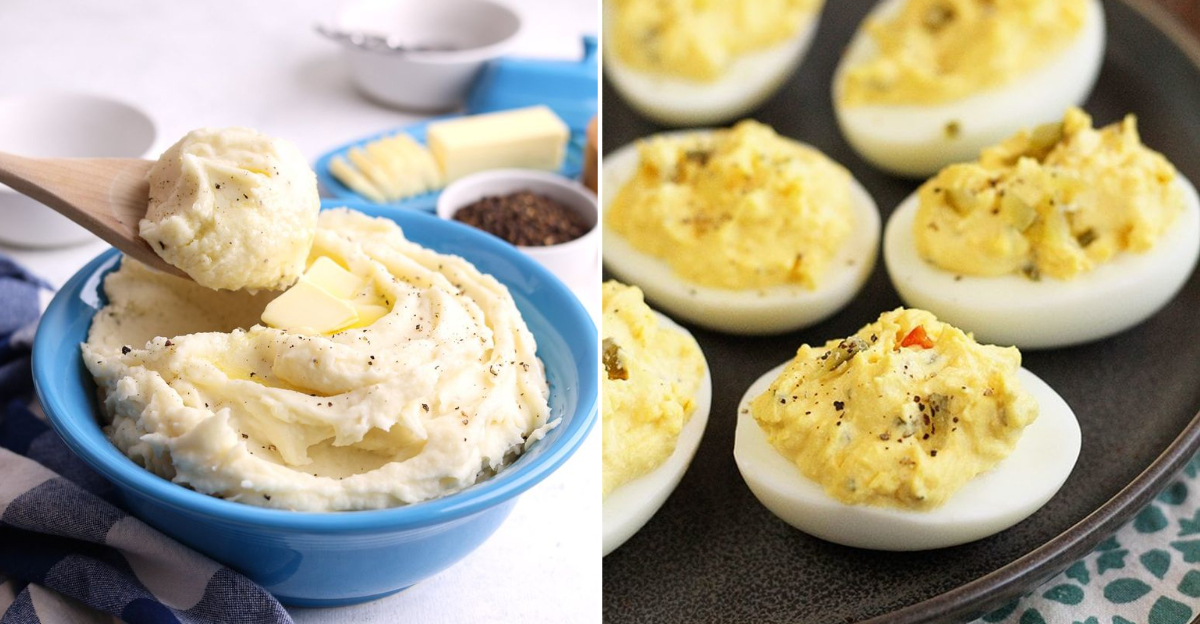16 Southern Favorites You’ve Probably Been Cooking The Wrong Way For Years

Southern cooking isn’t just about throwing ingredients together and hoping for the best. It’s an art form passed down through generations, with techniques that make all the difference between good and mind-blowing.
I grew up watching my grandma create magic in her kitchen, and learned that authentic Southern cooking has specific rules. Here are 16 Southern favorites you might be making incorrectly, and how to fix them.
1. Flaky Biscuits That Fall Flat
Cold butter is the secret weapon for perfect Southern biscuits. When that butter melts in the oven, it creates steam pockets that make your biscuits rise and develop those gorgeous, flaky layers.
I learned this the hard way after serving hockey pucks at my first family gathering. Keep everything cold, even the flour! Freeze your butter and grate it into the dry ingredients for best results.
And whatever you do, don’t twist that biscuit cutter; it seals the edges and prevents rising.
2. Gummy Grits That Nobody Wants
Stone-ground grits deserve respect, not the instant stuff in packets. Real grits need time, at least 30 minutes of gentle simmering while you stir occasionally to develop their creamy texture.
Use a ratio of 4:1 liquid to grits. Start with water, then finish with cream or milk for richness. Season properly too! Bland grits are a Southern crime.
Salt the cooking liquid before adding grits, then finish with butter and maybe some sharp cheddar.
3. Greasy Fried Chicken Disappointment
Temperature control makes or breaks fried chicken. Too hot and you’ll burn the outside while leaving the inside raw. Too cool and your chicken soaks up oil like a sponge.
My grandma taught me to listen to the chicken; a proper sizzle should sound consistent, not frantic. Maintain oil at 325-350°F using a thermometer. And please, brine that bird first!
An overnight soak in buttermilk with salt makes all the difference in juiciness and flavor penetration.
4. Tough, Chewy Collard Greens
Rushing collards is sacrilege in Southern kitchens. These sturdy greens need low, slow cooking to transform from leathery leaves to tender, flavorful delights.
Remove those tough center stems completely. They never soften properly. Start with a flavorful pot liquor by simmering ham hocks or bacon before adding your greens.
Then give them time, at least an hour, preferably two or three. Good collards can’t be rushed.
5. Cornbread That Crumbles Apart
Authentic Southern cornbread isn’t sweet cake! It should have a crisp exterior and be tender inside with pronounced corn flavor. The cardinal sin? Not preheating your cast iron skillet.
I once served cornbread that looked perfect but disintegrated when cut. Lesson learned! Now I heat my skillet with bacon fat until it’s smoking hot before pouring in the batter. That sizzle when batter hits hot iron creates that signature crust.
And remember, real Southern cornbread uses white cornmeal, not yellow.
6. Sad, Soggy Fried Green Tomatoes
Crispy fried green tomatoes start with proper selection. Choose firm, truly unripe tomatoes. If they’re starting to turn yellow, they’ll release too much moisture during cooking.
Slice them thick, at least 1/3 inch, so they hold their shape. My aunt Josephine taught me her three-step breading method: seasoned flour, then buttermilk, then cornmeal mixed with a bit of flour.
Let them rest after breading to set the coating before frying in oil that’s hot enough to sizzle immediately.
7. Dry, Overcooked Pulled Pork
Rushed pulled pork is a travesty. This Southern staple demands patience, cooking at low temperature (225-250°F) until the meat reaches about 195°F internally. This process can take 8-10 hours for a large shoulder.
The collagen needs time to break down completely. I’ve watched my dad tend his smoker all day, refusing to rush the process. If you’re using a slow cooker, don’t add too much liquid.
The meat releases its own juices. And never shred the meat while it’s still hot. Let it rest 30-45 minutes first.
8. Gluey Mashed Potatoes
Southern-style mashed potatoes should be fluffy and buttery, not sticky paste. The wrong potato is often the culprit. Use starchy russets or Yukon golds, not waxy varieties.
Start potatoes in cold water, then bring to a simmer. Hot water cooks the outside too quickly before the inside is done. Drain thoroughly and return to the hot pot to evaporate excess moisture. Most importantly, don’t overwork them!
Use a ricer for the smoothest results, or a hand masher for more texture.
9. Runny Banana Pudding Disaster
Traditional Southern banana pudding isn’t instant pudding from a box! The authentic version uses a custard made from scratch that’s thick enough to coat the back of a spoon.
I remember watching my grandmother whisking egg yolks into warm milk until the mixture thickened perfectly. She never rushed this step. Layer everything while the custard is still warm, placing vanilla wafers and banana slices against the glass bowl sides for presentation.
Then refrigerate overnight so the cookies soften and flavors meld beautifully.
10. Lifeless Deviled Eggs
Bland deviled eggs have no place at a Southern gathering. The filling should be smooth, creamy, and pack a flavor punch. Start with properly cooked eggs, no green rings around the yolks!
Use older eggs for easier peeling. After boiling, plunge immediately into ice water. For the filling, add a splash of pickle juice or vinegar for tang. A touch of Dijon mustard, not yellow, adds sophistication.
And please, use Duke’s mayonnaise; any true Southerner knows there’s no substitute.
11. Pasty, Flavorless Gravy
Good Southern gravy starts with drippings, whether from fried chicken, roast turkey, or country ham. These bits contain concentrated flavor that forms the foundation of exceptional gravy.
Sprinkle flour directly into the hot drippings and whisk until it turns golden brown. This roux development is crucial for both color and flavor. Then slowly add your liquid while whisking constantly to prevent lumps.
I once tried to rush this process at Thanksgiving and ended up with what looked like lumpy wallpaper paste. Never again!
12. Rock-Hard Peach Cobbler
Perfect peach cobbler should have a tender, biscuit-like topping that’s crisp on top but soaks up fruit juices underneath. Mixing the dough too much develops gluten, leading to tough results.
Handle the dough with a light touch, just enough to bring it together. For the filling, macerate your peaches with sugar first to draw out juices. This creates a natural syrup.
I learned from my great-aunt that adding a pinch of nutmeg alongside cinnamon brings out the peach flavor without overwhelming it.
13. Bitter, Oversteeped Sweet Tea
Sweet tea is the house wine of the South, and brewing it properly matters. Steeping tea bags too long in hot water releases bitter tannins that no amount of sugar can mask.
Bring water just to a boil, remove from heat, add tea bags, and steep for exactly 5 minutes, no longer! Remove bags without squeezing them (another source of bitterness). Add sugar while the tea is still hot so it dissolves completely.
The ratio? About 1 cup sugar per gallon for authentic Southern sweetness.
14. Soupy Pecan Pie Disappointment
Runny pecan pie filling ruins the experience of this Southern classic. The culprit is usually underbaking or incorrect proportions of eggs to sugar.
The filling should set up firm enough to slice cleanly, yet remain slightly gooey. My mother’s secret was adding a tablespoon of cornmeal to the filling; it absorbs excess moisture without changing the flavor.
And toast those pecans before adding them! It intensifies their flavor dramatically. Bake until the center jiggles only slightly when gently shaken.
15. Tough, Chewy Hushpuppies
Hushpuppies should be crisp outside, tender inside, not dense cornmeal bombs. Overmixing the batter develops gluten, making them tough. Stir just until ingredients are moistened, then stop!
Let the batter rest 10-15 minutes before frying. This allows the cornmeal to hydrate properly. I watched my grandfather add finely minced onion to his batter for flavor and moisture.
Oil temperature is crucial too. Maintain 365°F for perfectly golden, crisp exteriors without greasy insides.
16. Mushy Okra That Nobody Wants
Slimy okra turns people away from this wonderful Southern vegetable. The key to non-slimy okra? High heat and minimal moisture. Never wash okra right before cooking. Instead, pat it completely dry.
For frying, slice it and toss in cornmeal just before it hits the oil. For roasting, space pieces apart on the baking sheet so they crisp rather than steam.
My personal favorite trick came from my mother-in-law: adding a splash of vinegar or lemon juice to okra dishes helps cut the slime factor dramatically.
